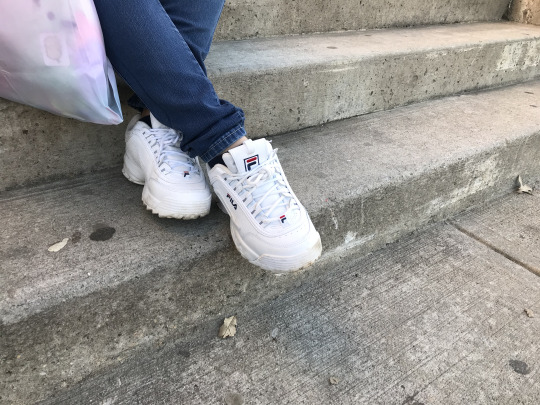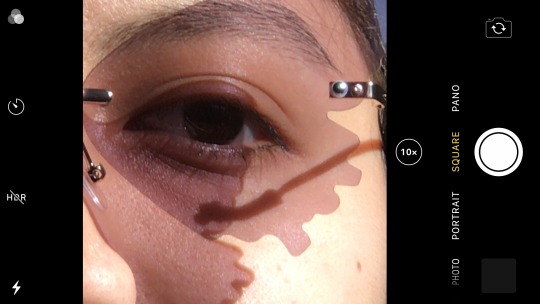Video
tumblr
“𝕐𝕠𝕦 𝕞𝕚𝕘𝕙𝕥 𝕗𝕖𝕖𝕝 𝕝𝕚𝕜𝕖 𝕚𝕥𝕤 𝕒𝕝𝕨𝕒𝕪𝕤 𝕟𝕚𝕘𝕙𝕥
𝔸𝕟𝕕 𝕨𝕖 𝕨𝕚𝕝𝕝 𝕒𝕝𝕨𝕒𝕪𝕤 𝕓𝕖 𝕒𝕝𝕠𝕟𝕖
𝔹𝕦𝕥 𝕥𝕙𝕖 𝕟𝕚𝕘𝕙𝕥 𝕚𝕤 𝕒𝕝𝕨𝕒𝕪𝕤 𝕥𝕙𝕖 𝕕𝕒𝕣𝕜𝕖𝕤𝕥
𝔹𝕖𝕗𝕠𝕣𝕖 𝕥𝕙𝕖 𝕗𝕚𝕣𝕤𝕥 𝕝𝕚𝕘𝕙𝕥 𝕠𝕗 𝕕𝕒𝕨𝕟”
-RM of BTS
2 notes
·
View notes
Photo
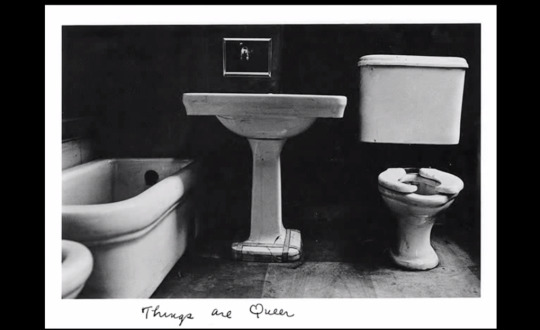
“Things are Queer” 1973

“Things are Queer” 1973

“The Bogeyman” 1973

“The Bogeyman” 1973
“Things are Queer”, taken in 1973 by Duane Michals. This body of work contains 9 photographs and is considered a circular narrative. All of the images are in black and white which gives us a sense of positive and negative space in the photos. Although none of the photos show anything queer. When looking at the first photograph, we see a bathroom with a tub, sink, and toilet. Nothing unusual about the photo. As we continue to look at the other photos, a foot is introduced in the frame. This foot belongs to a person, which seems to show that the bathroom is smaller. The next photo shows a thumb holding down a page of a book. And we see the pervious photo in the book. The photo before was taken from a book someone was reading. Next frames we see the person reading the book from a close and far point of view. This photo is seen in a frame hanging above the sink. Normally a mirror would be above the sink but instead a photo is hung above. This symbolized that the series was being mirrored. This whole series in looked as a loop. The frame zooms out and we see the sink. The last photo shows the same photo as the first one. Nothing in this series showed anything about queerness. When looking at the definition, queer is used as an umbrella term for sexual and gender minorities. Although queer used to mean strange or peculiar. This series is strange and not the usual norm we usually see in photos, especially in a narrative story. Theirs always a beginning and end, but for Michals he decided their was nether of those. This continuous loop was a failed way of capturing reality.
“The Bogeyman”, taken in 1973 is another piece of work that Duane Michals has worked on. This body of work contains 8 photos and is also a narrative piece. All of the photos are taken in one singular room. The location doesn’t change at all. The photos are also black and white to show the positive and negative space in the room. When looking at the photos, they are all connected and looks like a mini film. In the first photograph, theirs a little girl sitting on a chair reading and a coat hanger is next to her. The next few photographs show the girl looking at the hanger and getting up and examining it, curious who’s beneath the coat and hat. Once the girl sees no one she goes back to sit down. The next photo, the coat hanger is blurry, indicating that it’s moving. The last two photos, the coat and hat get off the hanger and go towards the girl and carry her away as she screams in fear. With the title, “The Bogeyman”, the coat hanger is supposed to represent the boogeyman who takes misbehaving children to teach them to behave better. Although in the photos, it’s not indicated that the girl was misbehaving. All we saw as the audience was her reading a book. Although when she opened the coat, she could have seen something she shouldn’t have, but curiosity got the best of her.
When looking at “Things are Queer” and “The Bogeyman”, both of these bodies of work are both narrative pieces. Michals was heavily influenced by photojournalism in the 1960s, that he used the medium and turned it to communicative narratives. Both of these pieces of works revolve around one certain subject and the location doesn’t change. For “Things are Queer”, it can be argued that it does have different locations from the bathroom to the book, to the alleyway, but this was all in one singular photo that was shown as a loop. Both of these photos are in black and white. Although Michals shows the positive and negative space in his photos differently with how close or far the subjects are. For the “Things are Queer”, when the foot entered the frame in the bathroom, the space became closer and little space was available. There was a lot to look at in the bathroom once we zoomed out and saw a whole person. Same goes for the other photos with how close we were to the book to zooming out of who was reading the book and then back to beginning in the bathroom. For “The Bogeyman”, the space around the room was empty. We as the audience was able to focus on the subjects and not much of the surrounding area. As for the narrative of each work, “Things are Queer”, didn’t have an ending. The loop of the photographs were on repeat and there was no telling when it’ll end. And nothing was mention about being queer in the photos. Although the message still sends even though there are no queer people in the photos. With the loop still going, it sends a message of failing to capture reality. That there is no world that exist where queer people don’t exist. By staying on this loop, it shows how others were living in a fantasy of having everything normal just as the photographs show. And as mentioned before, queer was used as strange and peculiar. And this topic related to Michals as well as he was a part of the LGBTQ+ community. As for “The Bogeyman”, the story wasn’t related to him. Michals wanted to portray fear and disturbance and used the boogeyman to create his series of photos.
Works Cited
Everyday, Vintage. “'The Bogeyman' by Duane Michals, 1973.” Vintage News Daily, 28 Oct. 2017, vintagenewsdaily.com/the-bogeyman-by-duane-michals-1973/.
Sprocket, Emerson. Duane Michals - "Things Are Queer" (as a Fairytale)., 1 Jan. 1970, www.philosophyof.photography/2015/02/duane-michals-things-are-queer-as.html.
thinkPhilosophy. “Queer Space: Duane Michals' Photographic Series ‘Things Are Queer.’” Medium, Medium, 26 June 2019, philosophypublics.medium.com/queer-space-duane-michals-photographic-series-things-are-queer-299c3a2721d0.
1 note
·
View note
Photo

Larry Clark’s is a American photographer and film director that showed explicit content of teenagers and young adults being self destructive. Most of the work he did was reflected from himself and his friends in his early twenties as he related more to the youth. Even as he entered his thirties, he still was recording the youth who were entering adulthood just as he was. His own life reflected his own work.
I found Clark’s work interesting with how raw his work is. He showed the audience uncomfortable scenes and the reality of youth. Although I can’t say he’s representing all of the youth, he is giving a taste to the audience of the youth. One of his latest work was a film called, “Marfa Girl” made in 2012, which is a film about a kid that’s 16 years old and is getting high, hanging out, and having sex. His films are “real” as Clark has lived them in his twenties. He has experienced the scenes he shows and isn’t just showing a bad name to the youth. That all this is normal.
1 note
·
View note
Photo

Ending: Taking a Moment in Life
I decided to narrate a story with pictures of everyday activities. With the first picture of waking up in the morning and not seeing what time it is. Getting up and ready for a new day. Looking at the photos its just sequences of events happening in a persons life. Sitting down to read a book. The Polaroid camera capturing moments that will last forever that wouldn't be seen ever again. The photo of looking out into a field, away from the busy life. Then turning around to the busy street as we walk back to reality and see the bikeway narrows sign, just like our own lives. Their may be a slump that we can’t see in the moment but once it all passes, we’ll be back looking at the whole road going our way. And then the day ends with an evening drive.
2 notes
·
View notes
Photo
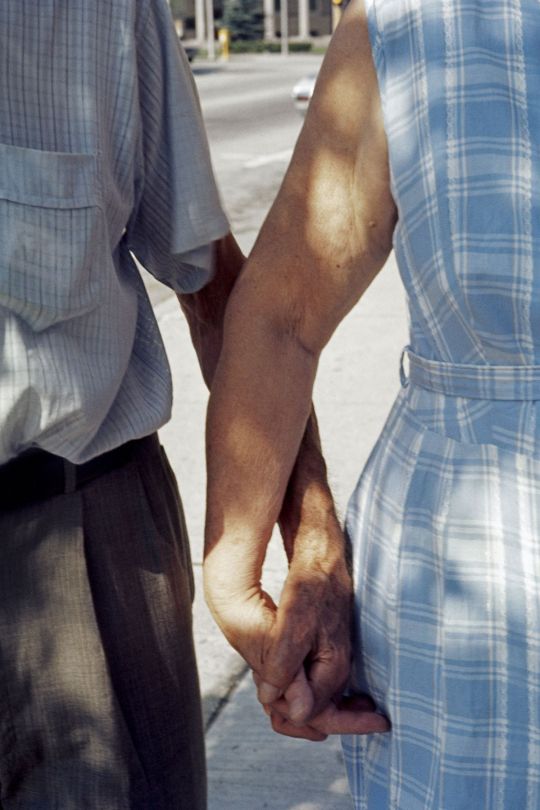
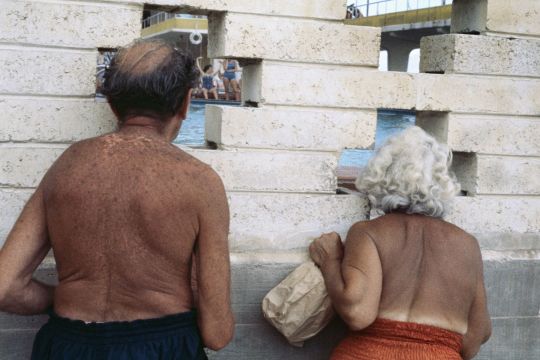
The Color Work by Vivian Maier, at the Howard Greenberg Gallery. There are a total of 23 photographs, but I chose two to write about. The first photograph was taken in Chicago, 1972. The second photograph was taken in Miami, FL, 1960. Both of these prints were on a chromogenic print at a size by 10 x 15 inches. The exhibit captures the streets life of New York and Chicago. The images shown are seen from the point of view of Mair. It was said that she photographed the study of human behavior from the gesture to facial expressions. None of her work was shown until John Maloof found her work in an auction.
Looking at the first photograph that was taken in Chicago, 1972; we see an old couple holding hands. This photograph shows the couples love for one another after all the years they spent together. I was intrigued by this photography because young couples sometimes don’t last long. They can be together for years but not feel love anymore for their partner. Maier also focused on taking a picture of part of their bodies. She wanted us as the audience to focus on the couples holding hands. For the second photograph, taken at Miami, FL, 1960; again we see an old couple looking out at a pool full of young people. This gives remembrance of when they were also young and had their time of fun. The old couple are also wearing swim wear. We have no idea if they just arrived at the pool or are leaving, but they seem to be outside of the area. And the old lady is carrying a paper bag. It could be her stuff or food the couple ate or are going to eat. ---She also has a tan line, so we can assume that they go to the pool together very often. When looking at both photographs, they were shown right next to each other. It was a said before that Maier would study human behavior. So we are looking at a couple that have lived their life. The enjoyment of their years together in a moment to looking back to the past.
The “staying power” in the photographs is straightforward. The enjoyment of life of one who used to live. When looking at the other photos, there were other people in the pictures living their life. One who is starting a new life to someones death bed. Its relevant to us today because even though the pictures shown don’t relate to us at the moment, we can still look at the past. Today we are still in a pandemic and its soon going to be a year since we have been in lock down. Back then we never realized a day would come where we have to stay away from people and stay shut in our own homes. All the times we’ve been able to see our family and friends has come to a stop. Of course we can still see them online, but we aren’t having any human interaction and are missing that part of our lives. We have no idea when the pandemic will end and in the future we look back at this time of history we lived in.
1 note
·
View note
Photo
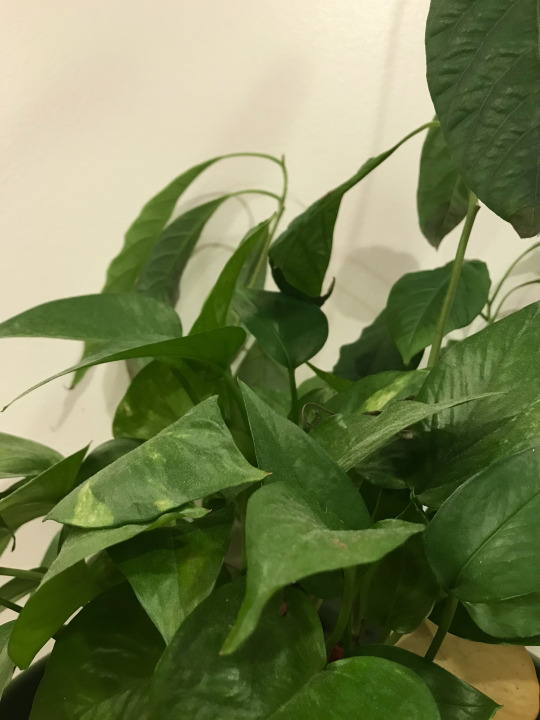
Plants 🌱
Organic forms
March 1, 2021; at 5:56 P.M.
🌙 Taken on iPhone
✨ Add more color to bring the green in the plants.
0 notes
Photo

Books📚
Indoors
February 25, 2021; at 2:59 P.M.
🌙 Taken on iPhone
✨ No edits made
3 notes
·
View notes



